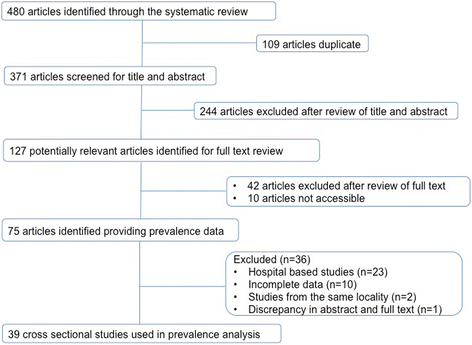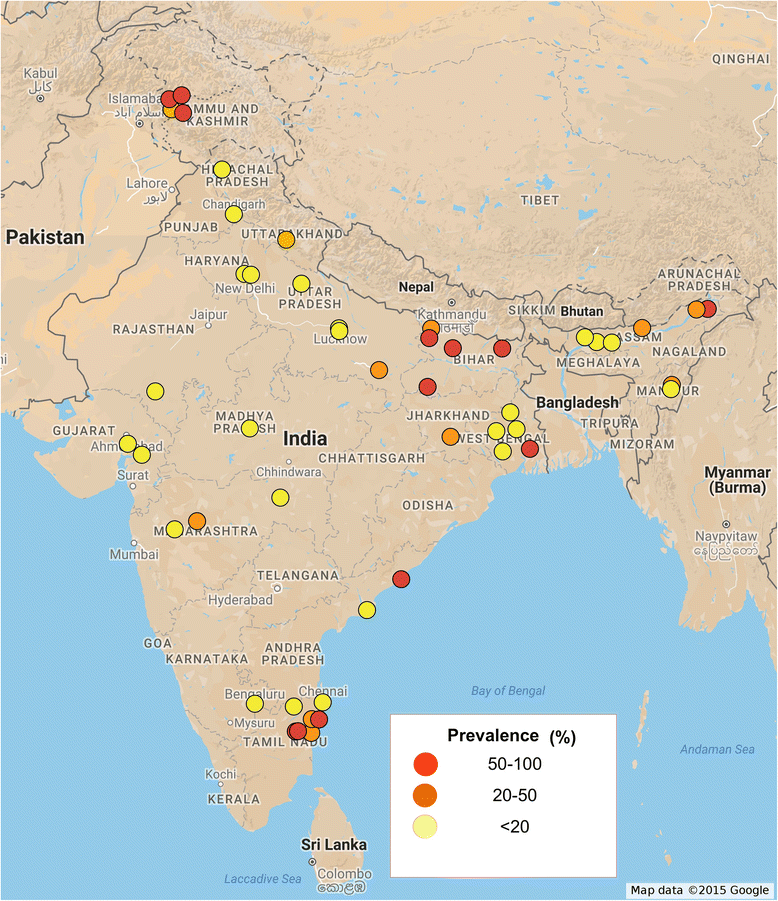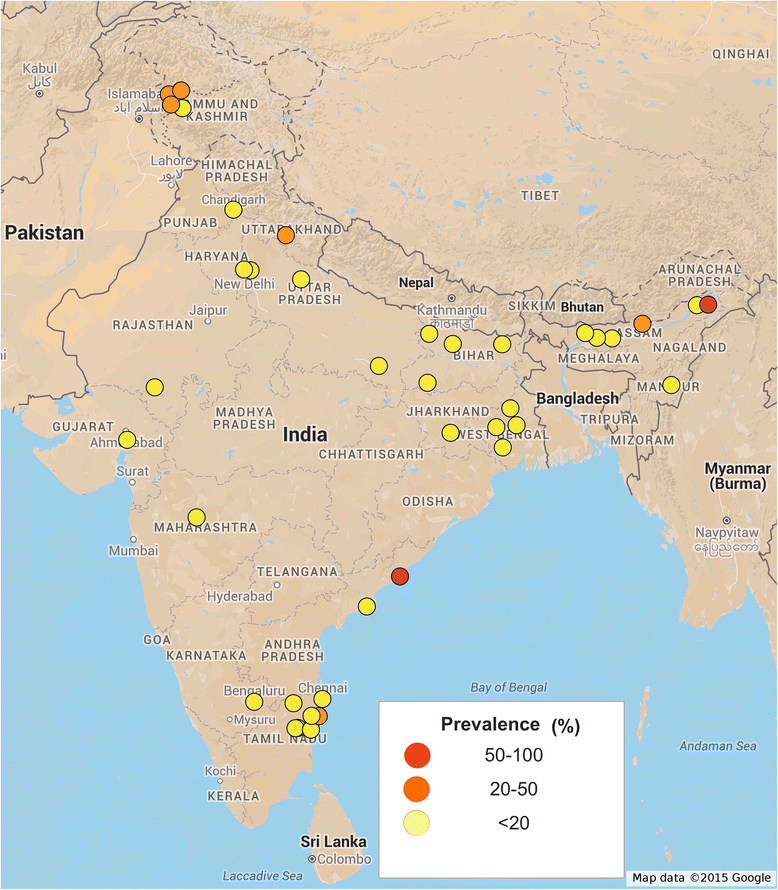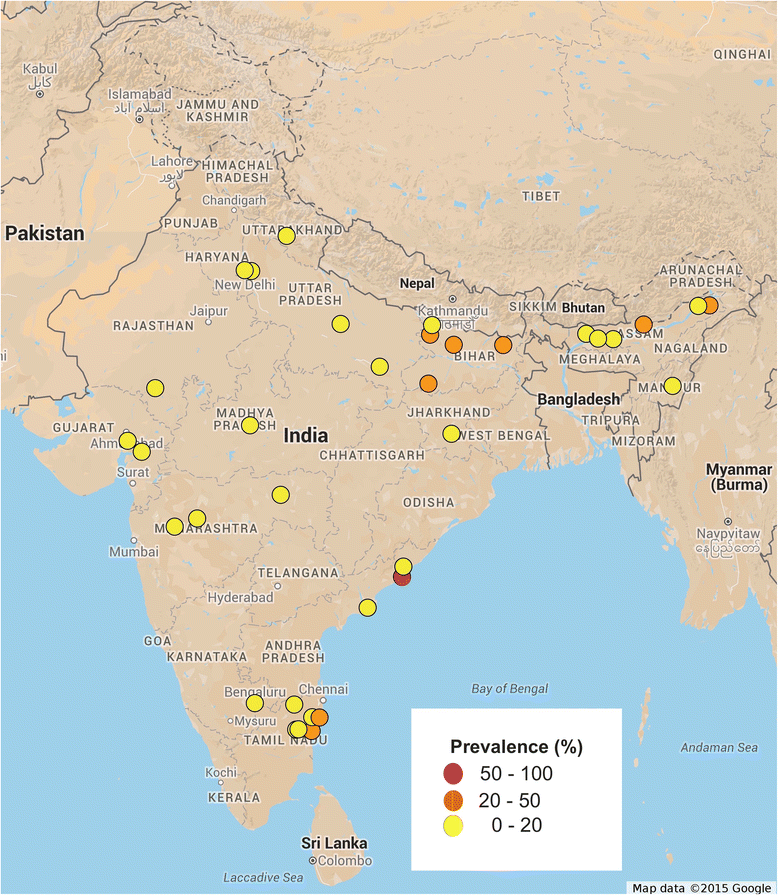Prevalence and distribution of soil-transmitted helminth infections in India
- PMID: 28209148
- PMCID: PMC5311856
- DOI: 10.1186/s12889-017-4113-2
Prevalence and distribution of soil-transmitted helminth infections in India
Abstract
Background: Understanding the prevalence of soil-transmitted helminth infections is necessary to plan control strategies and focus on highly endemic regions for preventive chemotherapy and improved sanitation facilities. India is known to be endemic for soil-transmitted helminth infections.
Methods: To understand the prevalence, spatial distribution and identify high-risk zones, a systematic search of published literature was carried out based on PRISMA guidelines from the year 2000 to 2015.
Results: A careful screening of the identified literature yielded 39 studies that reported the prevalence of soil-transmitted helminth infections from 19 different states of India. Ascaris lumbricoides was the most prevalent parasite. Higher than 50% prevalence was reported from six states. Nearly 90% studies reported the prevalence of more than one parasite species in the same sample population.
Conclusion: This is the first study to comprehensively review the literature associated with soil-transmitted helminth infections from India giving a clear idea of its prevalence, distribution and high endemic areas.
Figures




Similar articles
-
Bayesian risk profiling of soil-transmitted helminth infections and estimates of preventive chemotherapy for school-aged children in Côte d'Ivoire.Parasit Vectors. 2016 Mar 21;9:162. doi: 10.1186/s13071-016-1446-0. Parasit Vectors. 2016. PMID: 27000767 Free PMC article.
-
Spatial distribution of soil-transmitted helminths, including Strongyloides stercoralis, among children in Zanzibar.Geospat Health. 2008 Nov;3(1):47-56. doi: 10.4081/gh.2008.231. Geospat Health. 2008. PMID: 19021108
-
Water, sanitation and hygiene related risk factors for soil-transmitted helminth and Giardia duodenalis infections in rural communities in Timor-Leste.Int J Parasitol. 2016 Nov;46(12):771-779. doi: 10.1016/j.ijpara.2016.07.005. Epub 2016 Sep 8. Int J Parasitol. 2016. PMID: 27616734
-
Epidemiology of soil-transmitted helminthiases in Malaysia.Southeast Asian J Trop Med Public Health. 2011 May;42(3):527-38. Southeast Asian J Trop Med Public Health. 2011. PMID: 21706930 Review.
-
The Role of More Sensitive Helminth Diagnostics in Mass Drug Administration Campaigns: Elimination and Health Impacts.Adv Parasitol. 2016;94:343-392. doi: 10.1016/bs.apar.2016.08.005. Epub 2016 Oct 7. Adv Parasitol. 2016. PMID: 27756457 Review.
Cited by
-
Estimation of the Parasitic Burden of Soil-Transmitted Helminths Among Pregnant Women in the Maharashtra State of India Using qPCR: A Community-Based Study.Indian J Community Med. 2024 Jan-Feb;49(1):157-164. doi: 10.4103/ijcm.ijcm_249_23. Epub 2024 Jan 12. Indian J Community Med. 2024. PMID: 38425985 Free PMC article.
-
Spatial parasitology and the unmapped human helminthiases.Parasitology. 2023 Apr;150(4):391-399. doi: 10.1017/S0031182023000045. Epub 2023 Jan 12. Parasitology. 2023. PMID: 36632014 Free PMC article. Review.
-
Evaluation of opportunities to implement community-wide mass drug administration for interrupting transmission of soil-transmitted helminths infections in India.PLoS Negl Trop Dis. 2023 Mar 10;17(3):e0011176. doi: 10.1371/journal.pntd.0011176. eCollection 2023 Mar. PLoS Negl Trop Dis. 2023. PMID: 36897877 Free PMC article. Clinical Trial.
-
Strategies to Decrease the Prevalence of Soil-Transmitted Helminths in Central India.J Lab Physicians. 2022 Oct 20;15(2):202-206. doi: 10.1055/s-0042-1757417. eCollection 2023 Jun. J Lab Physicians. 2022. PMID: 37323609 Free PMC article.
-
Soil-transmitted Helminth Infection and Perinatal Outcomes in Pregnant Women in Primary Care Settings in South India: A Cohort Study.Indian J Community Med. 2024 Sep-Oct;49(5):719-725. doi: 10.4103/ijcm.ijcm_826_23. Epub 2024 Jun 24. Indian J Community Med. 2024. PMID: 39421507 Free PMC article.
References
-
- http://www.who.int/neglected_diseases/preventive_chemotherapy/sth/db/?un... Accessed on 31 Oct 2015.
Publication types
MeSH terms
Substances
LinkOut - more resources
Full Text Sources
Other Literature Sources

